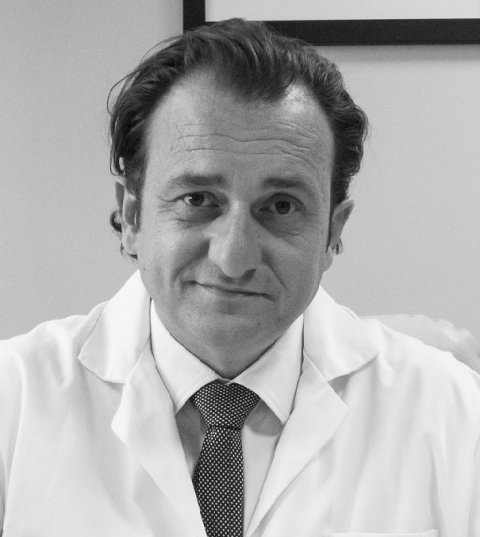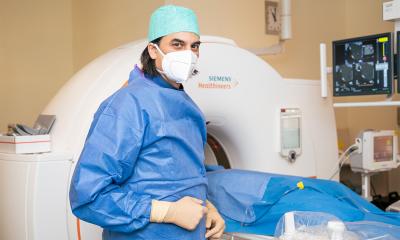© NASA/Shane Kimbrough, 2021
Article • Healthcare among the stars
Taking French interventional radiology to space
French interventional radiologists are pushing the frontier by looking at opportunities to perform minimally invasive procedures in manned space flights.
Report: Mélisande Rouger
A new strategy explored by the French Society of Radiology (SFR) is to equip astronauts with an interventional kit when flying outside of the earth’s orbit, a leading interventional radiologist explained ahead of the JFR, the SFR’s annual meeting that took place earlier this month.

‘Interventional radiology has a major role to play in the future story of space,’ said Vincent Vidal, a professor of interventional radiology at Aix-Marseille University and a radiologist at Assistance Publique – Hôpitaux de Marseille (AP-HM), one of the largest health centres in southern France.
When astronauts are stationed within the earth’s orbit, for example in the International Space Station (ISS), the medical risk is almost null. ‘If a crew member gets sick, we can connect with him or her and the physicians directly,’ he said. ‘In acute cases, we can even bring the astronaut back on earth within 24 hours.’ But during space flights to Mars or further, astronauts are completely on their own. Any communication to and from earth is delayed by about 20 minutes, and it can take up to 40 minutes for the medical team to know that there’s a problem. ‘There’s no possible interaction because of this delay,’ Vidal explained.
Another issue is the impossibility to bring heavy or large surgical equipment, due to space and weight restrictions in the spaceship. ‘That limits the quality of care you can deliver, and it means you can only perform small surgery and traumatology procedures during space flights.’
Recommended article

Article • Anatomy meets astronomy
French radiologists set their eyes on the stars
About 2,200 satellites are currently orbiting the Earth and soon space stations may be equipped with the latest medical imaging technology, including interventional radiology devices. In France, radiologists and astronauts are putting their heads together to make this vision materialise in a unique partnership between the French Society of Radiology (SFR) and the French Space Agency (CNES).
In this setting, interventional radiology presents with significant benefits. A small and light ultrasound device is easily transportable and allows to access organs deep inside the body, to put a needle and place a small catheter rapidly and safely. There are many indications that interventional radiology could help tackle in space, Vidal suggested. ‘Antibiotics may not always be enough to treat simple abdominal problems. Using a small ultrasound probe, we have a perfect access and can puncture an organ and drain a small abscess or injury in the abdomen,’ he said.
Another situation in which interventional radiology could help make a difference is renal colic. The condition is traditionally treated with drugs, but sometimes requires going one step further to avoid renal infection. ‘We can puncture the kidney, drain the abscess and save the astronaut.’
A polyvalent physician is always present during space flights. Equipped with the right tools, he or she can face almost every situation. ‘Science can fit on a USB stick, and we can bring pharmacopeia. We can also bring the right imaging devices.’
The Mars IR Tool Box Challenge
During the JFR 2021, Vidal challenged the main French radiology centers to create a polyvalent toolbox to carry out interventions in space. The initiative, called the Mars IR Tool Box Challenge, is led jointly by the SFR and the National Centre for Space Studies (CNES, in French: Centre national d'études spatiales), who started their partnership last year. A jury will deliver a prize to the team with the most pertinent solution at the JFR 2022. ‘The idea is to think of every possible scenario – biliary drainage, vesicle puncture, etc. – and combine them with the lightest, smallest and most versatile equipment we have on earth,’ Vidal said. He also invited the audience to think of interventional procedures that could be developed in space and translated back to earth. ‘Space is an interesting place to develop interventions that are traditionally performed with surgery,’ he said. Participants could get inspired by the situation in emerging countries, where radiologists must work with scarce resources. ‘Space puts us in a very similar setting as developing countries,’ said Vidal, who’s also active in Fair Embo, an association who works with benefactors all around the world. ‘We can’t work with plan A, so we need to work on plan B.’
Profile:
Vincent Vidal is the head of Interventional Radiology in the Imaging Department at Timone University Hospital in Marseille, Professor at the Faculty of Medicine and Director of the Experimental Interventional Imaging Laboratory at the Aix-Marseille University in France. Vidal received his M.D and Ph.D from the School of Medicine of Aix-Marseille University. He completed his research fellowship at the Toronto University and his clinical and research fellowship at the University of Montreal in Canada in 2003-2004. Prof. Vidal's research and clinical work are focused on embolization and he’s an active member of multiple interventional radiology societies (SIR, CIRSE, ESR, APSCVIR).
21.10.2021











